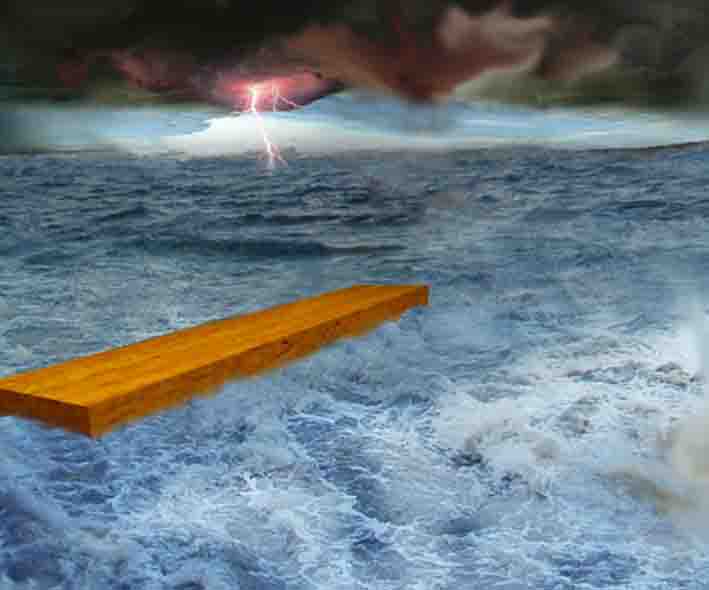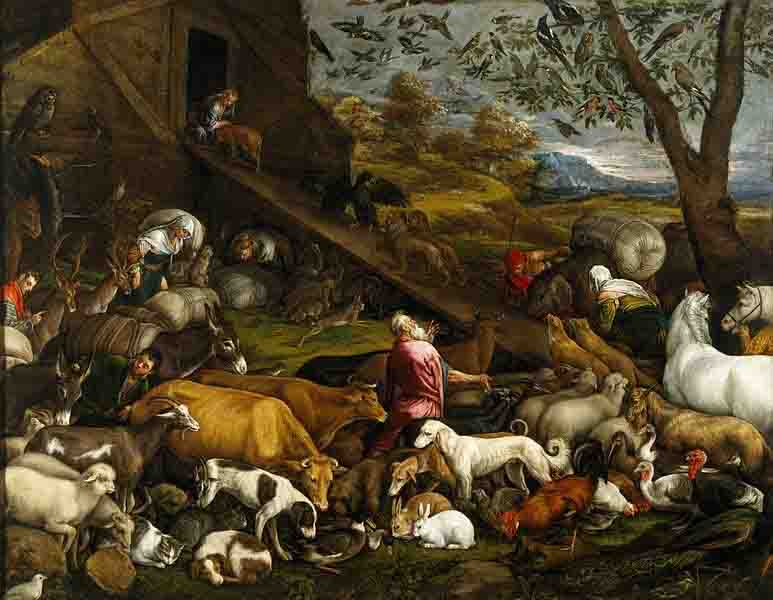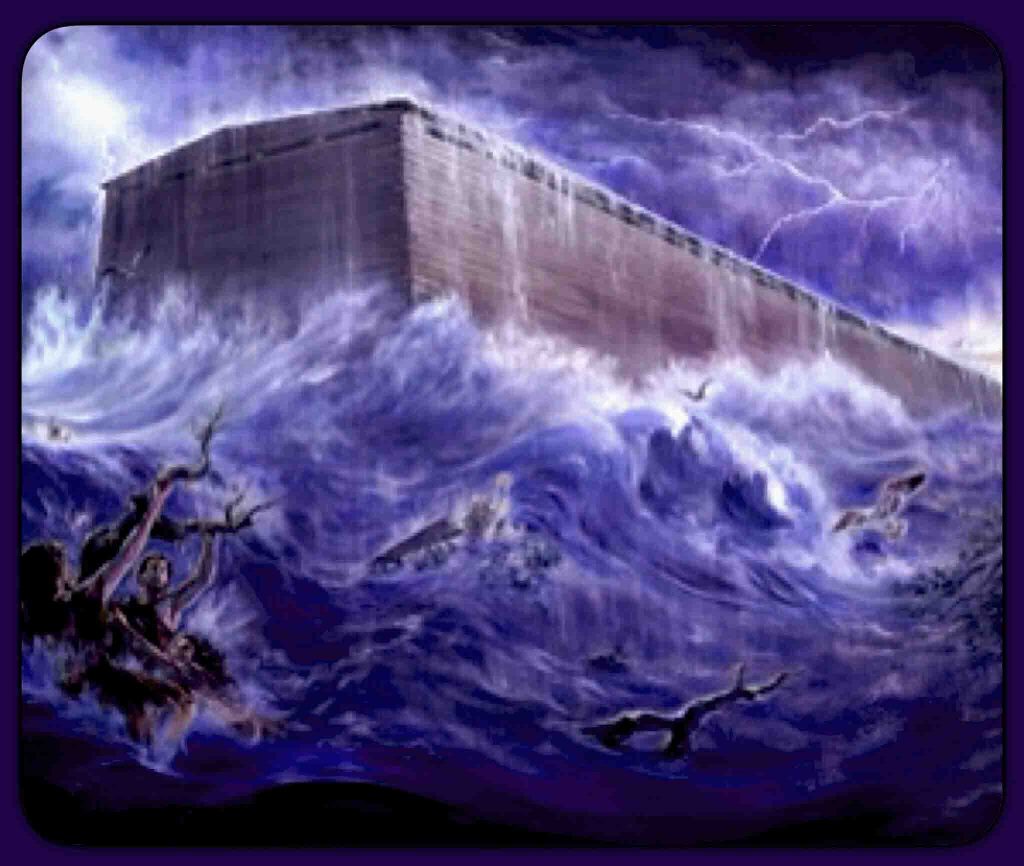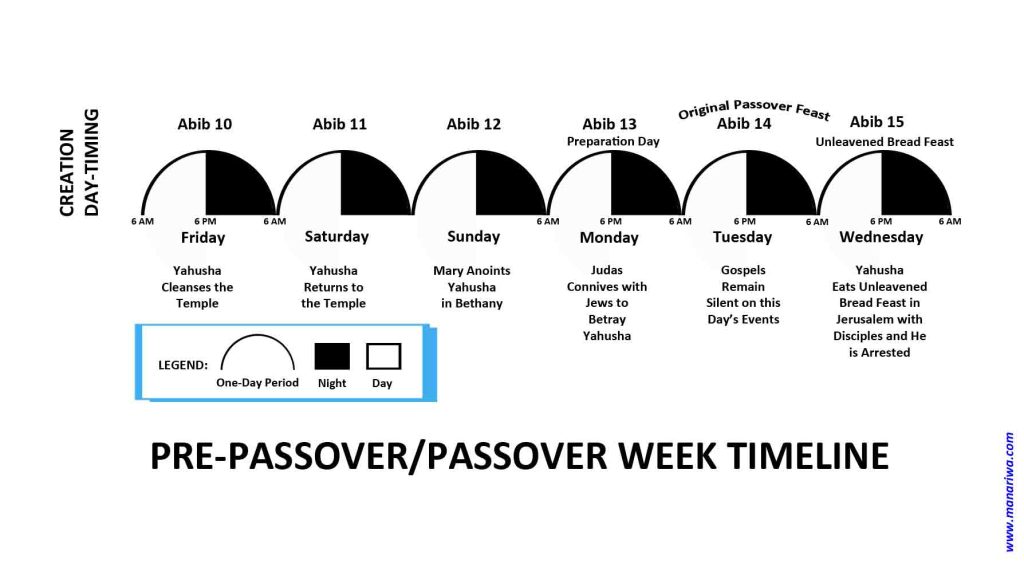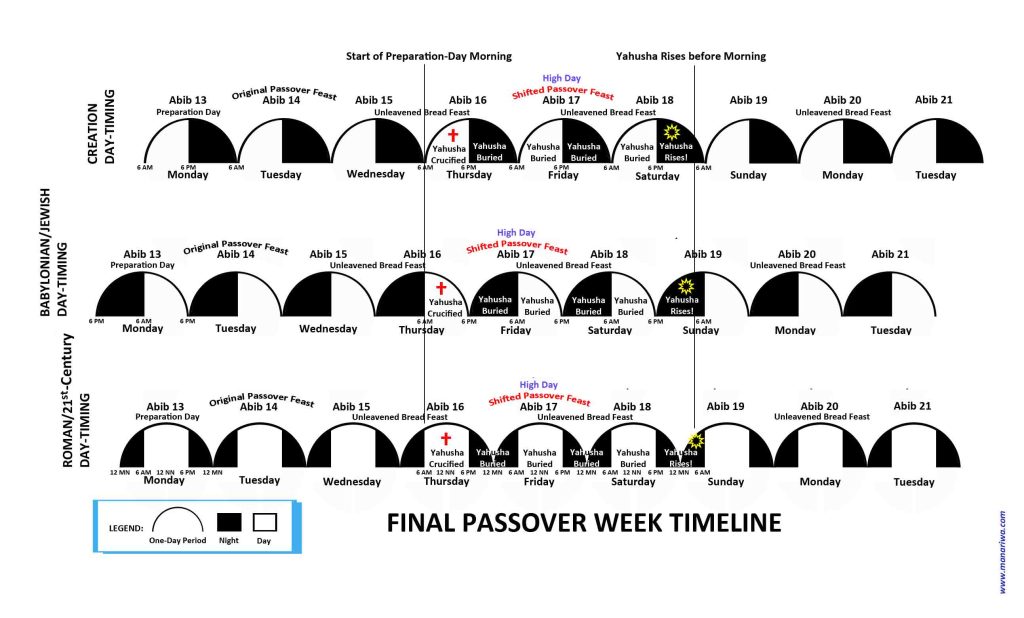52 Weeks in the Ark with Noah and Family (WEEK 18) – The Ark, the Exodus and the Resurrection Unified
WEEK 18 (17th to 23rd of Elul, the 6th Month, in the Hebrew Religious Calendar)
How Noah Built the Ark
We left the Ark for a while and took a detour to survey events during the apostles’ time. We go back to the Ark but will leave again to resolve a vital “un-rested” issue in the 1st century.
Many years before Noah was born, his great-great grandfather Enoch received the warning of a coming judgment through a global flood in which his descendant Noah will save only a few worthy souls alive. By then, the world had been besieged by hybrid humans who were the children of fallen angels who had mated with the “daughters of men”. (Gen. 6:1-2) This widely-growing belief has been reinforced through the discovery in 1947 of the Dead Sea Scrolls owned and kept by ancient Jews who had lived near Jordan River. John the Immerser, a Levite, was one of those who had grown up in that wilderness area of Bethabara and who would later proclaim the coming Kingdom and immerse the Lamb of Yah Himself.

One of the scrolls found were parchments of the Book of the Giants, which narrates the experiments done by the so-called Nephilim (often translated as “giants”, who were the children of fallen angels) of divinely-sourced techniques to create hybrid plants, animals and even humans through interbreeding (even between species as well: “all types of miscegenation”.) Although scientists deny the process as authentic genetic-engineering knowledge but rather sorcery or witchcraft, the results were not unlike the modern scientific methods which produce similar monster-like animals, only with greater precision. Which then is sorcery, which is not? The past 3 years have practically taught us that modern medicine has its roots in pharmakeia.

As hybrid beings themselves, those giants collected various species of animals which they interbred in order to produce new species. (Nada es nuevo bajo el sol!) Notably, their primary reason was to create animals and humans of superior quality, abilities and strength, as they themselves were “mighty men of renown” endowed with superb intelligence and abilities. Most likely, humans by then had become weak and limited in physical and intellectual capabilities due to sin, immorality and sickness. We can only imagine how much less-inferior we are today compared to those pre-Flood people. Just to live to be 600 or more and remain healthy and strong to build a huge structure, as Noah was, would surely make anyone today far superior than anyone who lived since the time of the apostles.
Their abominable deeds, however, had so enraged Yah that He decided to erase them from the face of the Earth. But Noah found favor with Yah, being a righteous and humble servant who kept the ways of his parents who had remained steadfast in their faith in the Creator. We can then appreciate why Yah would command Noah to choose the clean and unclean animals that would repopulate the coming New Earth. The phrase “clean and unclean animals” now takes on intriguing nuance. For it was terminology used much later on by Moses to teach the Levite priests to differentiate between clean and unclean animals, the former being the only ones to be eaten or offered on the altar. (Deut. 14:1-20)
So, why were some animals unclean; could they have been the by-products of the experiments done by the Nephilim before the Flood? Otherwise, what would make animals created by Yah to become inherently “unclean” if all He had created were “good”? And why include them in the Ark if they were tainted creatures formed by wicked spirits? Why not just the pure breeds that came from Creation? The only reason, perhaps, is that the Nephilim may have eradicated many of the original breeds, prompting Yah to preserve only the “neutral” hybrids that existed then and which have managed to survive until now. Hence, it seems the categorization that Moses knew and used much later on had originated from Noah himself who had firsthand knowledge and experience as to how the unclean animals came to be. That also explains why unclean animals were taken only in single pairs, as well as not being kosher later on. Imagine a husband whose wife had been raped by a crazed man: He can either kill or preserve the offspring of such a horrible deed. Yah might have had compassion on the half-breeds as well and, thus, preserved them.
As such, we have good reason to conclude that calves, sheep, goats, pigeons and some other animals that have remained “clean” since Creation were the only ones allowed to humans as food and as offering at the Temple. And when did we ever have epidemics that required people to be vaccinated against bites from cows, sheep, goats or pigeons? Such animals as dogs, cats, horses, pigs, rabbits, monkeys and others may have been products of interbreeding and, in all likelihood could possess lesser nutritive value and unnatural qualities, weaknesses and even abilities that make them unfit for ceremonial purposes. For what would make a pig that has cloven feet like the goat but does not chew its cud inherently unclean? (Leviticus 11:3) Unless it has something to do with its inner character, that is, its primal animus or animal spirit. Was Yahusha merely making up metaphors and mindlessly demeaning dogs and swine to teach people how to display their holiness; or was He pointing out that innate spiritual character that afflicts humans (and animals, as well?) who do not possess the “goodness” or “cleanness” of Yah in His sermon in Matt. 7:6?
And why people have learned to pet and love dogs and cats inordinately and, oftentimes, even treat like humans, if not gods, we can only ascribe to these creatures’ inherent animistic abilities to channel familiar or even wicked spirits, whose organic affinity to these types of animals allows them to manipulate these animals. It is a phenomenon that we have unknowingly taken for granted; but it has great spiritual significance we do not appreciate. We know for a fact that the Egyptians kept horses, dogs, cats, baboons and lions as pet animals and must have priced them not just for their endearing and magnificent traits but, often, for their magical or psychic abilities. Why they can relate well with humans and even sense lingering spirits is something worth considering or questioning.

Without doubt, some animals have the uncanny ability to mesmerize, lure or while away the attention of humans from more pressing and vital matters than caring for them as if they were family members who are, for the most part, unproductive and short-of burdensome house pets. They do serve as good animal assistants in such lines as police or farm work; but they generally do not give up their lives and flesh to satisfy our hunger and make us live, as goats and cows do. On the contrary, pet animals have mastered the Jedi Trick, which allows them to lead people to obey them rather than the other way around. That is where the danger lies: when the minds or spirits in animals could become channels for demons to exploit humans for inane, base or wicked purposes.
Hence, it hurts me more than anyone else to say this to dear friends: Beware how you relate or deal with pet animals. They could be leading you astray without your knowledge. Look into the eyes of some animals and you will not only sense their soul but, somehow, either their real animus (hatred) or rapport (devotion). But is this not how animals normally behave? Then why do we feel the same way with people? If hypocrites and swindlers have the uncanny ability to deceive us, that is because an impure or wicked spirit leads them astray — and can also lead us astray. Remember what happened to Havah when she became too familiar with an animal?
But we must admit, humans used to have the ability to communicate with animals in the Garden before the Fall. After the Fall and the coming of the Nephilim, communicating with them has remained a dangerous matter. Or even more so. This we must realize. Many of them could be literal “Trojan Horses” left behind by the Nephilim to serve as “spies” or “inside men” who will prepare the return of their angelic masters by diverting and weakening their human masters. Heard of the millionaire who died and bequeathed all her riches to her cat? Or why do people fancy more as online profile pictures their pets and not themselves, parents, children, beloved ones or heroes? Is this an innocent choice or modern practice we are belaboring? If only animals could talk, we could ask what they think of it. But, of course, a lion would only say, “Rrrr . . . !”
How Noah Cared for Animals
We should never take for granted what the Nephilim had done. And whether we paint a true or valid scenario or not, we are clear about the fact that Noah and his family took great care in choosing the animals they brought. It was no longer as easy as picking a wolf here or a panda there living in the forests. Most likely, it took them years of breeding those animals during the 120 years the Ark was being built in order to make sure the offspring of their original parents produced the same kind of species, perhaps, 3 or more generations apart. Yes, the text says the animals “went into the Ark to Noah” as if commanded by Yah; but they were tasked to choose the clean and unclean, not just bring them all in. Did they have a manual to use for classifying them? Breeding through proper pairing and observing the results alone, while studying their habits, taught them their real physical and primal nature. And they had to bring 7 pairs of the clean animals. That may have required learning their peculiar habits, diet, reproduction patterns, and growth rates to accommodate them in the Ark. Imagine bringing a 12-foot-high giraffe inside the 10-foot-high stalls in the Ark! And, did you know that rabbits can reproduce within about a month and bear up to a dozen babies? In one year, a pair of rabbits could have multiplied to more or less 60 or so unclean, non-edible animals! Did Noah, perhaps, know how to cull certain animals to prevent them from multiplying rapidly? Food was strictly rationed in the Ark.
But, what if Shem fancied bringing along a unicorn, perhaps, seeing what a beautiful and versatile creature it was, but not knowing it was a mix-breeding of a horse and a bird? Or Ham picking a T-Rex that was certainly an awesome and mighty animal worth keeping as a species for posterity, but also not realizing it was a reptilian hybrid bred by the Nephilim? Noah’s Ark now becomes more than just a nursery story for kids we tell to enamor them with pictures of cute animals but a tale of vast and deep importance in divine and human history.
Preparing Food for the Builders and Riders of the Ark
Then there was the preparation for their food for one year inside the Ark. It seems, aside from building the Ark and raising animals fit for reproduction, Noah’s company also spent daily work at their farms to feed themselves, the animals and their workers who may have helped them in their work. the women must have spent much time learning to dry and preserve fruits and vegetables, as well as gather grains and nuts and other plants for storage. With so much work, they must have had relatives (all people were more-or-less close relatives then) who may have helped them build the Ark, if not procure materials, water and food they needed. They must have also traded or dealt socially somehow with people during the 120 years they worked. After all, they were seeking to find as many who would join them in the Ark. Besides, with Nephilim seeking to cause harm on humans during that time, they probably needed a way to defend themselves against attacks and attempts to stop their work. It would not have been unlikely that, for such a gigantic project, Noah’s enemies had no idea whatsoever that it was indeed a survival tool against a coming calamity that would gravely affect them. Hence, for Noah, securing his community must have required having friendly people to protect it and preserve the work he was doing.
Phases of Building the Ark
Essentially, there were 3 phases in building the Ark with a rough time-estimates of the schedule, namely:
- Cutting down trees (40 years)
- Drying and paring lumber to size (40 years)
- Assembling the Ark (40 years)
(Note: The number of years shown are not precise chronological values but assumed effective durations of working-years spent in each work segment.)
We said that Noah needed straight logs 300 cubits long (134 meters) to make a seamless structure from end-to-end. Certainly, he lacked no sources for 500-year-old (or even older trees planted way back in Creation) gopher wood for that purpose, so huge in diameter that each would make square lumber no less than 5 meters by 5 meters. Cutting that into half or more lengthwise would have given him durable flooring for the Ark, and thinner planks for sidings and roofing. Cutting a 500-foot-high, 5-meter-diameter tree alone would probably take 8 to 10 people to cut and many more people to roll it into place in a clearing where it can be dried for months or even years. (Now, we know why it took them 120 years to build the Ark.)
After the wood had dried and seasoned in the rainless environment, it was pared into the required thickness and length needed for the structure. Now, we might ask, with such huge lumber, how could only 4 men manage to do all that work? Indeed! That is why we said they must have had much help from relatives. However, there is the odd possibility that Noah may have had friends and relatives who were giants and had some of them on site to ease much of their work. Why not? We know there are some friendly giants, like Paul Bunyan (who was certainly cut out for Ark work) and Bernardo Carpio (a Herculean-hero figure of Marikina, Rizal). Who can say they are mere products of myths, as thousands have said of Nephilim and Titans for centuries? And if the Egyptians had a way to transport 10-ton granite blocks for miles, why should it be that much more difficult for Noah to move less-heavier lumber within 5 miles or less? For we presume that Noah must have chosen a site where there was ample supply of wood already and in a flat area where rolling logs would have made his work easier. There is the possibility that given his age of 580 years when he started, he, his father Lamech, or his grandfather Methuselah (or even Enoch) could have planted those trees for the Ark in a wide plain where Noah could build the Ark when the trees would have grown for up after 1 millennium. Methuselah was 969 when the Flood came and he died, as prophesied by the name Enoch gave him, which means “when it comes, he will die”) giving us the needed 1,000 or so years to grow proper-sized trees for the Ark.
The final assembly and finishing of the Ark was a much more meticulous portion of the work because of the necessity of ensuring it was watertight and durable to withstand the forces upon it from underneath, as well as due to its own weight and cargo load. How Noah knew how to do it must have been due to his long experience as a ship-builder. This fact further proves our original statement that Noah lived by the Great Sea in the East at the ends of the Earth, where the water was deep and allowed him to learn building toy ships as a child, encouraged most-certainly by Enoch, until he grew up learning how to build huge ships and sailing across the sea for nearly 500 years before he was commissioned to build the Ark. Where do you go to a school today for 5 centuries to study naval architecture, animal husbandry and agriculture before you finally get your first global contract?

By the way, gopher wood has not been clearly identified as coming from any specific indigenous species of tree; although some say it is acacia, which is not the best wood for shipbuilding. The more likely candidate is a type of rosewood available in the land where Ophir settled much later on after the Flood. The word “gopher wood“, according to some scholars, should be properly identified as Ophir wood, which Solomon himself brought from Ophir and used to build and decorate the Temple with – and even to make harps for his choirs, aside from using the proverbial cedars of Lebanon. The natives of modern Ophir call the tree narra, a tropical hardwood priced for its red tint, smooth texture and durability. It is also the national tree of the Philippines.
120 Years of Building and its Prophetic Meaning
The length of time Noah spent building the Ark was also the length of time Yah gave all humans, including Nephilim it seems, to repent and turn back to Him. But we ask: Could Nephilim be saved? How could hybrid humans, sired and raised by fallen angels, become obedient creatures? Perhaps, the patience of Yah was directed only at organic humans, not the hybrids. They were, after all, a minority, compared to the descendants of Adam who had multiplied upon the Earth and who now reeled under the abominable deeds of those hybrids and their monstrous creatures. Or, perhaps, because those Nephilim enslaved or taught humans to become depraved, they themselves did the same grievous sins and, thereby, brought more corruption upon the world. Wars and murders were so rampant, aside from what we had described earlier. The depth of sin was so great Yah would decide to destroy all wicked flesh on Earth.
Yah’s patience during Noah’s labors would be paralleled by His patience in Moses’ life before He would finally save and bless the seed He promised to Abraham. Moses lived for 40 years as a prince in the palace of Pharaoh, 40 years as a shepherd in Midian, and 40 years as a prophet-leader of Israel. For 3 centuries or so, the Hebrews had been slaves in Egypt until Yah sent Moses to bring them out with great display of powers. In a parallel way, therefore, Moses was also cutting down trees to build mighty structures for Pharaoh, as chief-builder and architect. All the riches of the land were his to own and use as he chose because he was a son of the Pharaoh’s daughter. For another 40 years, Moses shed off his wealth and power to become a shepherd, just as Noah trimmed down all the logs into required sizes. Showing off one’s character according to the design of Yah required much strength, diligence and suffering. The true color of lumber comes out underneath the bark as sap and grain are scraped away to bring out the glow and strength of the inner, hardened wood intended to build a strong structure. Moses built his inner character in the desert and eventually met Yahuah to complete his training for the task given to him.
The final 40 years of Moses made him a builder of a nation, just as Noah spent 40 years completing the Ark into what it was supposed to stand and serve. Moses was able to establish a nation right in the wilderness, the place of Yah’s people’s sufferings. As Noah also formed a small portable nation (a virtual world!) he would carry within the Ark through his faithful family and menagerie on their journey to save the Earth. Moses’ final destination could have been his grand entrance into Canaan and the claiming of the Promised Land. However, the rebellious people prevented him from reaching his goal, though mainly due to his own fault. He had to bequeath to Joshua the task of conquering Canaan, as Noah had to pass on to Shem the task of becoming the leader of the future world after the Flood.
When Peter and Paul taught the way to salvation, they used the Flood and the Hebrews’ exodus from Egypt as their examples. The water that lifted up the Ark and Noah’s company saved them in the same way that immersion saves a believer, not by the washing away of filth but the response of a good conscience. (1 Pet. 3:18-21) Likewise, the Hebrews were immersed in the cloud and the sea as they escaped from the army of Pharaoh which drowned when it pursued them. (1 Cor. 10:1-4) This idea of immersing a boat or a group of people pictures a divine process of the complete and encompassing effect and influence of Yah’s power, whether by water or by suffering and death, leading to full transformation and bestowal of a new character and purpose never before experienced or seen. Hence, immersion is also seen as a figure or metaphor for the salvation of a person. The old person who once was separated from Yahusha is immersed or buried in the water of immersion, no longer to rise. (Rom. 6:1-6) The one who rises is a new person cleansed of sins and renewed in the Light of Ruach. Even Noah and his family, still hidden in the dark confines of the Ark, will come out and once again see the Light from Heaven shine upon a renewed Earth that will offer them a new life and a new home.
The Resurrection in Review (Back to the First Century)
In much the same manner, the death of Yahusha underwent the same process. Like Jonah who spent 3 days inside the belly of the great fish, He died and was buried on the Fifth Day (Thursday), remained dead on the Sixth Day (Friday) and arose before the end of the Seventh Day (Saturday). Even His life was a 3-part duration of 10-year periods: The first 10 He spent as a boy following His parents around in Nazareth and learning to become a normal child; the next 10 years He spent learning more about scriptures and imparting His wisdom to others as a teenager, including the teachers of the Law, showing them how much He knew even before His eventual declaration of the Truth; and, finally, the last 10 years of His life as a young adult were spent consolidating His learning and growing as a mature human being; then for 3 years and the rest of His life, teaching, healing and revealing Himself as He really was and fulfilling His mission. And, yes, He had to spend 3 days in the tomb. Exactly what happened during those 3 days has become an unending controversy still. We have dealt lengthily with it previously. However, we have to revisit it in order to fully answer the nagging questions that remain.
If not for the satisfaction of many or just one reader, this question has to be fully resolved for this blog’s sake. Then we can move on. Noah himself provided log-notes of his life during the time he built and rode the Ark to pass on accurate and reliable facts for posterity to know and understand the real events during the Great Flood. What more with the resurrection of Masshiak? While Noah and his family then eagerly wait for the Waters to subside, we might as well settle this issue, hoping the flood of arguments, debates and the confusing traditions that believers have made for themselves based on their various doctrines could be finally replaced by the revealed truth and provide for many, once and for all, greater unity among believers.
We know this issue has been tackled throughout the past centuries; and we do not presume to erase all those controversies and propose a perfect view. But, by faith, we know Ruach undoubtedly has a perfect view. Why would He keep us in the dark or desire that we do not agree on His revealed Word? We just do not know it; or we have not seen and discerned among the many available views what or which it really is. What does Ruach truly reveal and say about it? For we presume that for such a vital event and momentous miracle for humanity, we, as a whole and especially the believers, should have one solid conclusion backed up by indisputable evidences.
Final Passover Week Timeline
Let us then review the timeline of the events leading to the last Passover Feast and the Feast of Unleavened Bread, as well as the death and resurrection of Yahusha. (Please refer to the illustration below.)
- In Matt. 24-25, Yahusha delivers a long message that may have lasted a couple of hours or more, including Q&A, perhaps. Before He delivered that message, He had just spent almost the whole day at the Temple where He had cleansed the Temple. We know it is the 10th day of Abib (a Friday).
- In Matt. 26:2, the following day, He returns to the Temple to teach and also condemns the Pharisees, Scribes and lawyers. He later declares that “after 2 days” the Passover Feast would come; which proves it was indeed the 11th day of Abib (a Saturday); for 2 days after the 11th (that is, when the 12th day and the 13th day have passed) is the 14th of Abib (a Tuesday), the Passover Feast Day.
- In Matt. 26:6, He visits Peter, a leper, in Bethany. This could already be the 12th day of Abib (a Sunday). There a woman anointed Him with precious perfume – we know it is Mary, the sister of Lazarus. Yahusha had been in Bethany as early as 6 days before Passover, most probably to be close to Yerushalem for the coming festival season (about 2 miles). (John 12:1-3)
- In Matt. 26:14-16, Judas connives with the Pharisees to betray Yahusha. This could be the events on the 13th day of Abib (a Monday), the day before Passover. Which means Judas left the group in Bethany, supposedly on a pretended errand to collect money, which we now know he did but received instead blood-money for himself from the Pharisees.
- In Matt. 26:17-19, the timeline somehow breaks down. The 14th of Abib (a Tuesday) is supposed to be the day of the Passover. However, the account of Matthew jumps to the First Day of Unleavened Bread which should occur the day after Passover, i.e., already the 15th of Abib (a Wednesday)! He tells the disciples to ask another disciple in Yerushalem to prepare the Passover meal for them that same evening. Apparently so, for the lamb is supposed to be killed and eaten in the twilight of the 14th; however, it was already the 15th. (Ex. 12:6) What happened?
How do we resolve the discrepancy? The original Passover was held on the 14th day of Abib; and it was commanded to be held on that same day through all future generations of Israelites. But notice that on the night of their escape from Egypt, the Hebrews ate both lamb and unleavened bread together in one meal; for they were in a haste to leave Egypt. (Ex. 12:8) It was only later on that the lamb was separated from the unleavened bread, making them into two essentially separate feasts: Passover Feast (1 day) and Feast of Unleavened Bread (7 days). The whole celebration lasted then from 14th to 21st of Abib, 8 days in all. (Mark seems to present another scenario which does not seem to be consistent with the rest of the writers.1)
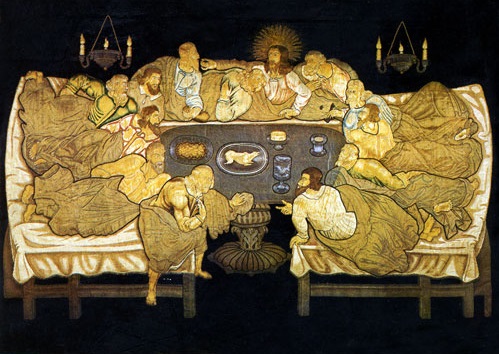
However, knowing His time was about to come for His sacrifice, separating the two feasts would have meant two nights of feast-meals, each one having vital significance to His teachings and His sacrificial offering in reference to the Law. Did Yahusha then unite the two on one night and in one feast-meal? And so, we have the announcement of the New Covenant of flesh and His blood in one event. And this happened, not on Passover Evening the day before but on the 15th of Abib, a Wednesday. So far, this works perfectly well with our estimation as to when He died and resurrected. He died the following day, on a Thursday, and 2 days after or, on the third day, He resurrected. Resolved! Perfectly accomplished and delivered without breaking a step in the Law, except for, well, a slight timing adjustment. Who could question the “Passover” Himself in Person when He would partake of the lamb? After all, He was the real “Paschal Offering”, the “Lamb of Yah” Himself in flesh and body. The commandment, likewise, came from Him and He was not breaking it by not obeying it but obeying it by His own supreme will and choice.
But does not that make Yahusha flimsy or arbitrary? For all the rest of the Jews had eaten the Passover the past night and they are eating it one day late. Or have they? Well, not really, that night, all the Jews were celebrating the first night of the Unleavened Bread Feast in their homes, and for the next whole week. The question of the disciples gives us clue as to the dilemma they were also facing? For “on the first day of Unleavened Bread the disciples came to Jesus and asked, ‘Where do You want us to prepare for You to eat the Passover?”’ (Matt. 26:17) It almost sounds so embarrassing or amusing to ask of the Lord; but they had to ask. Could they have had eaten already the Passover lamb the previous night somewhere else and that they knew He had not? Hence, the question in those words: “to prepare for You to eat”, not “for us all to eat”. Whatever it was, it becomes clear that the decision had been made and they would have the two feasts both at the same time prepared that evening for them all, as also apparently borne by Mark.
From the above, we conclude that Yahusha died on 16th of Abib, a Thursday, buried before Sundown and remained buried on the 17th, a Friday, until the 18th, a Saturday, and arose in the evening before Sunday morning arrived. This bears our original conclusion and puts the issue to rest for the satisfaction of those who see the testimony of Ruach in scriptures. Notice, further that while He died at around 3 PM of Thursday, He remained a full day buried on the 17th of Abib and must have spent almost a day in the tomb on Saturday.
But Hold the Butcher’s Knife, There is More!
Having written the above, several passages arose and threw some of our assumptions across the Temple floor in pieces! Here are the verses that derail our almost fit-to-a-T defense:
Then they led Yahusha from Caiaphas to the Praetorium, and it was early morning. But they themselves did not go into the Praetorium, lest they should be defiled, but that they might eat the Passover.
Therefore, because it was the Preparation Day, that the bodies should not remain on the cross on the Sabbath (for that Sabbath was a high day), the Jews asked Pilate that their legs might be broken, and that they might be taken away.
The first verse seems to debunk our assumption that the Passover had been eaten, although it could mean that John was using the word “Passover” loosely to mean it was the “Feast of Unleavened Bread” the murderous Jews intended to eat. The 2 are used interchangeably, as we read in Luke 22:1. However, the second verse totally crushes our assumption because that day, Thursday, was “the Preparation Day” for the Sabbath, a high day! What did John mean by that? It was only Thursday, as we said, not Friday. (Please refer to the illustration above.) And what is a “high day”?
In Ex. 12:18-20, the Passover, in general apparently, was to be celebrated from the 14th day to the 21st day of Abib, that is, in 8 days. It was a commemoration of the actual events during the night the Hebrews escaped Egyptian slavery. On that night, Moses commanded an unblemished, one-year-old lamb to be killed, its blood sprinkled on the doorposts, and then roasted and eaten along with unleavened bread. Their salvation became the basis for the 2-in-1 celebration of the separate Passover Feast and the Feast of Unleavened Bread. The lamb was eaten on the 14th day and unleavened bread eaten from the 15th to the 21st of the month of Abib. A convocation was to be held on the first day and on the final day. No work was to be done on those days of gathering; that is, they were considered as Sabbaths.
So, it appears then that the day Yahusha died, Thursday, was a Preparation Day for the Sabbath which was the Passover or Paschal Meal they intended to eat on Friday still! And Passover was a “high day”, meaning, it was a special day of celebration prior to the weekly Sabbath that would follow it the next day. Yes, 2 Sabbaths were to follow the Preparation Day; and it meant the work to be done was double than the usual, as they would have to prepare food for 2 days instead of just one. And the lamb was good only for one-night serving, not 2 nights. For whatever remained was to be burned. So, perhaps, Saturday was fish-night or beef-steak night with unleavened bread?
But the problem is, if the Passover Feast was supposed to be eaten on the 14th, why was it moved to Friday, the 17th, instead? What caused this mysterious shift that has confused so many people for centuries? For we stand firm on our conclusion earlier that Yahusha and His disciples had the first night of the Feast of Unleavened Bread prepared on a Wednesday. (Matt. 26:17-19) And we know the days of the Passover week are fixed; for we can count down from Pentecost Day, held on the 50th day after Passover, which always fell on a Sunday (after 7 weeks or 49 days transpire). We can then retrace Passover Feast back on a Tuesday and the Feast of Unleavened Bread on a Wednesday. It seems we need more digging into this dark tunnel.
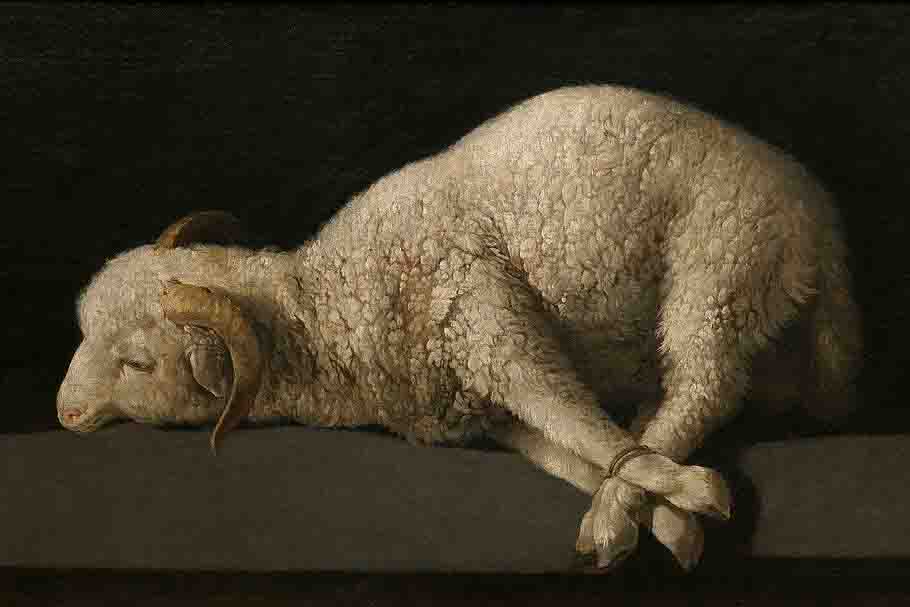
The Cleansing of the Temple
Something happened on the Savior’s way to the cross – a tradition-breaking and nation-shaking event only He could perform. From Ex. 12:3-6, the Israelites emulated the example of the Hebrews in Egypt by picking an unblemished year-old lamb on the 10th day of Abib. For although it was not directly commanded by Moses, it had the force of a law, just the same, by virtue of his authoritative word and example. They were to keep the lamb until the 14th and to kill it at twilight on that day. As such, we can then confidently conclude that 5 days before Passover week began, the Israelites were supposed to have procured or gotten ready a lamb which they fed well and cared for before being sacrificed and eaten for the feast. We can them imagine the whole Yerushalem population going about their ways to make sure that tradition was fulfilled. (Much like shopping on Christmas Eve.) And for so many visiting pilgrims from foreign lands who had come to celebrate the feasts, buying a lamb was the only option they had. Unless they had relatives in Yerushalem or nearby who had helped raise for them a lamb the past year for that purpose.
So, where do the majority of the people in Yerushalem turn to get their Paschal Lamb? The Temple. And since that is where they spent much of their time for daily prayers and offerings anyway, they must have intended to crowded the Temple courtyards that day to buy a lamb. But as the Father in Heaven would have it, His Son was also on His way to the Temple and was being welcomed and received by thousands of people lining the streets and shouting hosannas. And He entered the Temple with his many disciples, along with the multitude, into the Temple courtyards and confronted the money-chargers who had turned the Temple into a marketplace. He then overturns their tables and drives away all their animals out of the Temple. We can imagine many of His disciples following His lead and totally cleansing the Temple of the noise, filth and corruption that had taken over it. They took over the Temple courts and used it to teach and to heal the sick. (The outer court was about half-a-hectare in size and could easily accommodate over 20,000 people standing abreast at a time. We can imagine how many lambs the moneychangers brought inside for their business that day.) Hence, the cleansing of the Temple was a significant victory for the proclaimed Masshiak who had made a triumphant entry into the Holy City. It must have driven a sword into the hearts of the Jewish leaders.
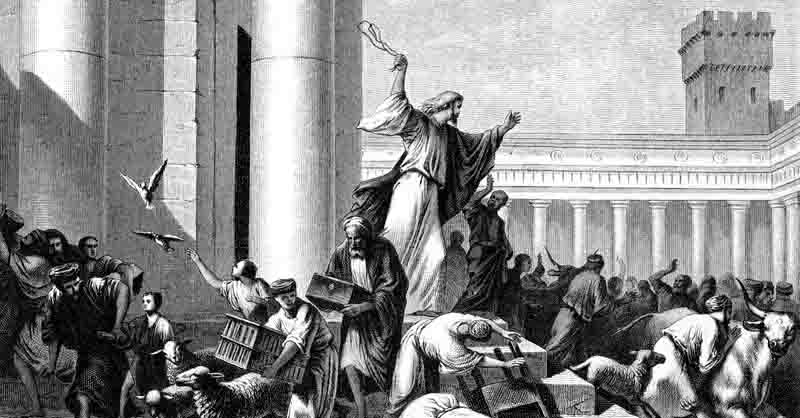
The following day, a Sabbath, when He returned to the Temple, the Pharisees, Scribes and Lawyer who had been enraged by His actions the previous day, confronted Him. He must have returned to make sure the Temple remained cleansed; for we do not see Him driving animals and peddlers again. Besides, He had come to unleash his 7 curses against those vile leaders and teachers — part of His goal to completely cleanse the Temple. He had taken off the legs of the monsters the day before. He was now cutting off the body and arms of the beast running the Temple. Only the vicious head remained. But by then, the majority of the people who had come to procure their lambs the previous day had been confused and disoriented because of the uproar and disorder in the Temple and the whole city.
That is probably why the Jews kept questioning Him in order to entrap Him in His words and bring Him to judgment; for they could not move against Him for fear of the people who had joined Him. Hence, their instruction to silence Him was put during the feasts in order to avoid “uproar” or rioting by the people. (Matt. 26:5) In their desire to protect the Temple as well, their supposed domain, they wanted to prevent further rebellious or violent acts by the people through His prodding. As a direct result, many of the people must have complained about the disruption of their duty to procure lambs from the animal peddlers. They must have pressed the authorities to be allowed to fulfill their duty the following day, Sunday, as they were not allowed to bear load on the Sabbath. The peddlers must have been allowed to set up shop outside of the Temple.
Yahusha’s appearance that day must have led the Jews to believe a rebellion was on foot which was going to be as big as that of the Maccabeans which led to the cleansing of the Temple from the Greeks in 2nd century BC. They, thus, plotted to kill Him. (Matt. 26:1-4) That Sabbath day, however, gave the people the rest they would need for the momentous events that would unfold the following week. It also gave the Jews the time to make their move.
It becomes apparent that the cleansing of the Temple led to a decision to move the Feast of Passover 3 days forward. For the 10th was a Friday, and the following day being a Sabbath, the coming Monday, the 12th was, therefore, designated as “general market day” outside the Temple or somewhere else for people to buy their lambs. The weekend would give the authorities to secure the city and to calm down the populace before normalcy could be restored. However, the primary solution was to get rid of the ring-leader of the insurrection, Yahusha. And so, the leaders worked double-time on Judas and pressed him to surrender his Master on or before the Feast of Unleavened Day arrived. Or, at least, before the Passover Feast on Friday later that week. And Judas did deliver Him on the night they finished eating on the first night of Unleavened Bread. Which means, Yahusha, the apostles and practically the whole of Yerushalem had not eaten the Passover Feast yet! That should settle the minds of so many people who have wondered at this question. It is the only plausible, if not, credible, reason for the discrepancies in the timing and the actions of the people involved.
Moreover, the conclusions above apply, whether we use the timing of the day-start at Sundown (per the Jewish reckoning), at Midnight (per the Roman reckoning), or at Sunrise (per Elohim’s reckoning on Creation), as the illustration above shows. This we have settled beforehand. The only conclusion that will vary according to which reckoning we use is the Day of Resurrection, which we have settled to be on a Sabbath.
Significance of Passover Feast Merging with Unleavened Bread Feast
We see then that while the original Passover night was a unified event and divided into separate feasts under the Law of Moses, the Final Passover became once again a completely-integrated act in that it not only recalled the past historical event of a nation centuries ago but, more so, it provided a glorious fulfillment of many prophecies that had long been awaited by that nation and the world. Here are a few significant aspects of that turn of events:
- The day set for the slaughter of the lambs for the Passover, Thursday, was also the day that the nation, through its leaders, slaughtered the prophesied Lamb of Yah. The blood of pure, innocent lambs mixed with the blood of the pure, innocent Son of Yah upon the ground. Since the lambs were to be killed at twilight, which would be about 15 minutes or less before 6 PM in the month of Nisan (Mar and April equivalent), by the time Yahusha was dead and being buried, thousands of lambs in Yerushalem were also being slaughtered for Passover. This also parallels the events in Egypt when the firstborn of the Egyptians died on Passover Evening while hundreds of lambs were being slaughtered. The blood of lambs saved the Hebrews; the blood of the Lamb of Yah will save Israel and the world.
- It appears Yahusha had no need to eat of the Paschal Lamb. Why? It would have been superfluous or anticlimactic. The sacrificial lamb was a symbol of death which He Himself was eager to undergo. However, the preferred picture He wanted to emphasize, it seems, is His being the Bread of Life, which is why that feast takes 7 days. Eating the lamb first and saying, “This is My body”; and then eating the bread in the same meal and saying the very same thing would be quite confusing for people. One was enough; and what He left for us is sufficient and complete.
- The Preparation Day on Thursday was so significant in that it presaged the twin Sabbaths that gave the slain Son of Yah two full days in the tomb (for His body) and two full days in Paradise (for His spirit) when He visited the departed souls there. Imagine the hope He brought to those souls awaiting His triumphant visit that time. And He brought the thief on the cross as evidence of His own crucifixion and triumph to cross the “deep chasm” between Life and Death. His visit was His assurance that He was fulfilling the Covenant in the beginning. Yet, He had to return to Life to finish His work.
- The fulfillment of the Paschal Lamb shedding His blood for the sin of the world was necessary to appease the anger and satisfy the justice of the Father. Likewise, the Unleavened Bread representing the pure, unblemished body of Yahusha lay in the tomb, anointed with 100 pounds of aloe and myrrh by Nicodemus, not that it needed all that spice; but it was to fulfill prophecy that He was a King and deserved the honor and glory of one. No cost was left to make sure He received the same, if not greater, reverence that David and Solomon had received.
- While the people, therefore, ate the Paschal Lamb and the unleavened bread together that night (for the first time since the time Moses held the Passover), they did so not knowing they had also sacrificed the pleasing sacrifice to appease Yah and partook of the bread that embodied His pure body offering. Ironically, their own grievous sin that day would provide themselves and many others the only escape from their sins and their own death. And at least 3,000 would avail of that grace later. (Acts 2:36-41) If this does not prove Yah’s mysterious ways, nothing will.
- And as the city settled peacefully that night to take its Sabbath rest for that night and on the following day and night, the leaders would be lulled into their complacency that they had gotten rid of a dangerous rebel and His group of fanatics. They had no idea that the Temple and their honorable positions would soon be taken away from them, part of the judgment upon those who rejected the offering of the Savior.
- As for the disciples and apostles who must have felt so hearted-broken and disappointed, the climactic events of that day which their 3-year sojourn with their extraordinary Master must have confused and despaired them no end, and, worse, on that highly-important day in their nation’s history. Their Moses-like figure of a leader and mentor seemed to have failed to bring them across the Bloody Red Sea. All His promises seemed to die with Him for good. How many of them really believed He would rise on the third day? Even His tomb was being guarded tightly by Roman soldiers. If the Jews’ hatred killed Him, what could have stopped the military might of the Romans?
- The Lamb-Body was roasted (burned) to show the abominable nature of sin He eliminated through His offering. The Bread-Body was anointed and preserved by spices to show the value of the earthly body Elohim had created in the beginning as the vessel of His image and which Yahusha redeemed by His sacrifice of a sinless life. The Creation Sabbath was finally fulfilled by 2 Sabbaths (Friday and Saturday), one for those who had entered into the Old Covenant and one for those who will enter into His New Covenant. Thus, He “rested” from, “set aside” or “completed” His work of redeeming humans from the curse of sin and death.
- The first Sabbath on Friday signified the RENEWAL of the completion or perfection of humans who were made on the Sixth Day of Creation (Friday); and the second Sabbath in Saturday, the RENEWAL of the completion or perfection of Elohim’s work on the Seventh Day (Saturday) of Creation. The head of the monster was finally crushed. (Gen. 3:15) WHAT WAS LOST WAS FOUND AND REDEEMED. ALL HAS BEEN FINISHED AND FULFILLED. Yahusha accomplished it on Passover Week. Hence, that feast and all the others have been fulfilled, giving no more need for observing them in our times. We only await the Final Rest.
- Finally, a precautionary note for those who persist on the misplaced timing of Yahusha’s Resurrection on the First Day, Sunday. As we can see in the illustration above, putting the Evening ahead of Day, as the Babylonian-Jewish system does, clearly leads to an erroneous conclusion. Likewise, for the Romans and modern societies, putting half of the Evening ahead (beginning the day at midnight, that is) leads to the same error. Here is where we can all have a welcome and beneficial reset to set things right. Let us all walk in step with the Creator of Light, Time and Life!
Final 120 Days of Yahusha on Earth
The 120-year pattern in Noah’s and Moses’ lives also appears in the final 120 days Yahusha spent on the Earth. In John 10:22-23, He walks in Solomon’s porch inside the Temple on the Feast of the Dedication, a Jewish Feast celebrating the rededication of the Temple after the Maccabean victory against the Greeks in 164 BC. The significance of the day and the place mentioned puts the soon-to-be-sacrificed Lamb of Yah upon the mountain chosen by Solomon’s father, David, on which to build the Temple. Although it was Solomon who built the Temple, He would destroy it and, instead, proceed to sit on David’s throne. Or more precisely, to reclaim the throne which He had loaned to both David and Solomon. It was only due to the hardness of the people that Yah allowed them to have a king.
Did He come to rededicate Himself as well to His Father. Most likely, as He would also pray fervently in the Garden of Gethsemane to commit again to the great sacrifice He was sent to offer. A porch is often a place used by a homeowner to rest in and survey the surrounding area, in this case the once-glorious city of Yerushalem. Yet, at that moment, He must have been foreseeing what will happen there in a several weeks. And how, eventually all those magnificent columns, walls and floorings would be thrown down because of the wickedness that had filled the Temple. Those remaining 40 years of the Temple, were for all intents and purposes, the final, dying moments of the Temple, the city and the people. And He was to offer his own life to make it all happen; so that a New and Better Temple not made by hands would be put up with much better, more-lasting promises. When Yahusha encountered the Pharisees in the Temple that day, He finally and openly admitted He was the Son of Yah and that He and the Father were one. From that time on, they sought to kill Him for committing blatant blasphemy, and while He was inside the Temple at that. What a brave and fitting way to rededicate Himself to His mission!

The Feast of Dedication is held on the 25th of Kislev to the 2nd of Tevet. It is almost 120 days until the end of the 8-day Passover Week. And about 40 days before Passover Feast would have been around the time Yahusha would raise Lazarus from the grave in Bethany. No other miracle would have matched this unprecedented raising of his friend Lazarus, who had been dead for 4 days. What better way to telegraph to the Pharisees that He was indeed the promised Masshiak and Son of Yah than to raise a person from the dead? However, they became even more envious and furious. Another 40 days after His Resurrection, He would ascend and sit on the right hand of the Father in Heaven — a bonus 40-day period of His Resurrected Presence on Earth mirroring His Spiritual Presence in Paradise when He would both assure his disciples, living or dead, He was the Son of Yah and the Promised Masshiak.
The Ark that Noah built, the nation that Moses built, and the Temple that Solomon had built which bade farewell to its Maker and Owner on Passover Week, were all handiworks of the Creator through the faithful workmanship of His chosen servants. Everything we have surveyed from Creation until the days of the Ark, so far, points to the culminating work that Yahusha would accomplish through His own life during Passover Week and through the time of reformation when He would ultimately “cease” or “complete” His own work of saving humans. (Heb. 9:9-10) We have outlined the whole process of that unparalleled divine work for the benefit of humans. A few unresolved and unfinished tasks in this universal drama remain which Elohim alone know and comprehend. We feel so privileged to be given front-seat view of Their glorious deeds and, expectedly, their Final Act of Judgment in the Last Day. Hallelu Elohim! Amen!
Notes:
1Mark 14:12 Interlinear renders the passage in Greek as “the Passover Lamb they were to sacrifice”, meaning “supposed to be sacrificed”; or that was the intention, at least. It does not categorically state that they did sacrifice it, as other versions seem to render it. Whether Mark is being inconsistent with other writers or it had become a practice for some to join the Lamb with the first day of the Feast of Unleavened Bread we do not know. What is clear is that all the accounts on the Last Passover meal never mention the Lamb being eaten, only the bread. And even if they did eat the Lamb that night, that does not affect the fact that the Jews, in general, had their Passover Lamb in the Evening of Friday (Abib 17, Jewish Day-timing).
